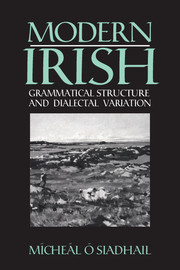Book contents
- Frontmatter
- Contents
- Dedication
- List of tables
- List of figures
- Preface
- List of abbreviations
- 0 General introduction
- Part I Phonology
- 1 Introduction to Phonology
- 2 The syllabic system
- 3 The vowels
- 4 The semi-vowel and consonant systems
- Part II Morphology
- Part III Syntax
- Glossary
- References
- Index of Irish words
1 - Introduction to Phonology
Published online by Cambridge University Press: 05 June 2012
- Frontmatter
- Contents
- Dedication
- List of tables
- List of figures
- Preface
- List of abbreviations
- 0 General introduction
- Part I Phonology
- 1 Introduction to Phonology
- 2 The syllabic system
- 3 The vowels
- 4 The semi-vowel and consonant systems
- Part II Morphology
- Part III Syntax
- Glossary
- References
- Index of Irish words
Summary
There are four chapters in Part I. This chapter sketches the approach to the phonology and explains some terms such as ‘underlying form’, ‘derivation’, ‘surface form’ and the distinction between ‘major’ and ‘minor’ rules. In Chapter 2 there is a brief general account of the syllable, how it may be arranged and how the accent is distributed. Chapter 3 deals with vowels and their development in certain circumstances and Chapter 4 discusses the treatment of semi-vowels and consonants.
The approach
While Part I deals with the sounds of Irish and how they change and are affected by their environment, there are inevitably innumerable minor differences from locality to locality in the actual phonetic realization of particular sounds. The account, however, is concerned with a more abstract level in order to attempt to describe the relationship within the underlying sound system and in doing so to specify the outstanding differences between the major dialects. (For a distinctive feature analysis of the Irish sound system see Ó Siadhail and Wigger 1975:14.)
The approach to the various phonological rules is a dynamic one and hence naturally the order in which they apply can be of importance. This means that the ordering of these rules is often adverted to in the course of the discussion. The distribution or the order in which a particular rule applies is often what constitutes a difference between the major dialects.
- Type
- Chapter
- Information
- Modern IrishGrammatical Structure and Dialectal Variation, pp. 15 - 18Publisher: Cambridge University PressPrint publication year: 1989



